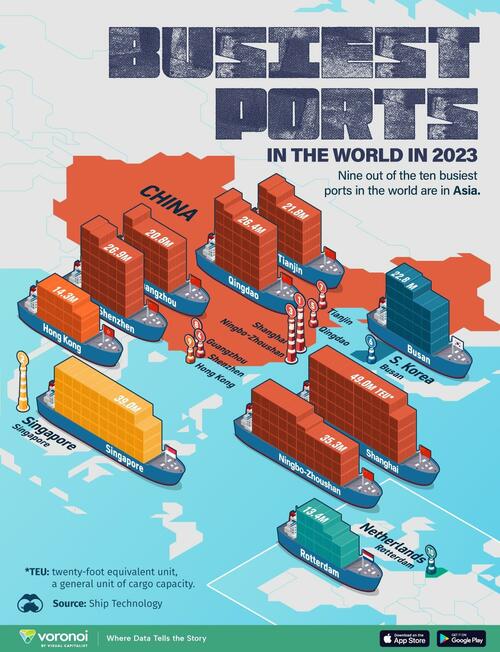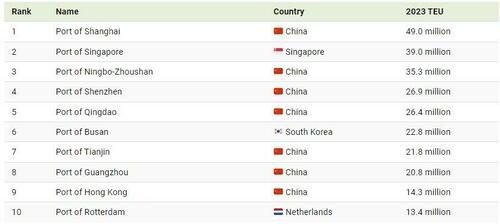These Are The 10 Busiest Ports In The World, By Cargo Traffic
In 2024, nine of the world’s 10 busiest ports are located in Asia, underscoring the eastward shift in global trade flows.
Due to supply chain shifts and deeper integration, intraregional trade within Asia has grown significantly.
In the 1990s, over 70% of Asian exports by value went beyond the region, with containers being shipped back mostly empty.
By comparison, roughly 60% of exports in Asia are traded within the region today.
This graphic, via Visual Capitalist's Dorothy Neufeld, shows the busiest ports in the world in 2024, based on data from Ship Technology.
The Busiest Ports in the World
Here are the 10 busiest container ports in the world by annual TEU traffic in 2023. TEU stands for twenty-foot equivalent unit, a general unit of cargo capacity.
As we can see, seven out of the 10 busiest ports in the world are located in China, illustrating its central role in global manufacturing and trade.
Since 2009, the country has been the largest exporter of goods in the world. The expansion and modernization of China’s port network are pivotal to the Belt and Road Initiative (BRI). As a global infrastructure development strategy adopted by China in 2013, the BRI is aimed at expanding connectivity and trade between Asia, Europe, and Africa through creating extensive networks of railways, energy pipelines, highways, and shipping routes.
Standing as the second-largest port globally, the Port of Singapore recorded 39 million TEU in 2023. Each year, 130,000 vessels enter the port, which is connected to 600 ports across more than 120 countries worldwide. Not only that, 1,000 vessels are located at the port at any given time in the day.
Beyond Asia, the Port of Rotterdam in the Netherlands is the leading hub in Europe. With origins tracing back to the 15th century, the port spans about 40 km (25 mi) long and 10 km (6 mi) wide. More recently, the Port of Rotterdam is working on autonomous shipping projects with several partners, allowing vessels to be operated remotely with the use of cameras and sensors, serving as the ships’ eyes and ears.



